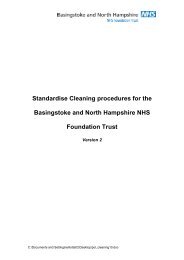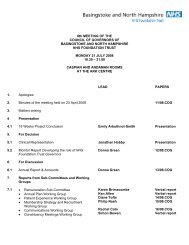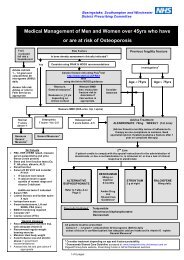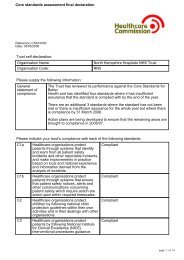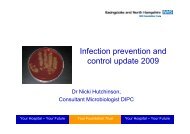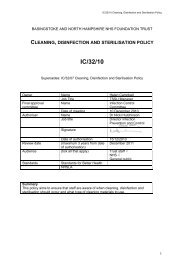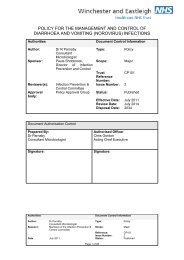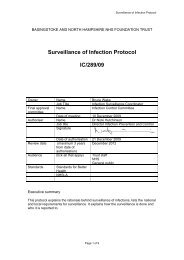Isolation and infectious diseases policy - Hampshire Hospitals NHS ...
Isolation and infectious diseases policy - Hampshire Hospitals NHS ...
Isolation and infectious diseases policy - Hampshire Hospitals NHS ...
Create successful ePaper yourself
Turn your PDF publications into a flip-book with our unique Google optimized e-Paper software.
Winchester & Eastleigh Healthcare <strong>NHS</strong> Trust<br />
Policy for <strong>Isolation</strong> <strong>and</strong> Infectious Diseases Policy<br />
Any patient found to be infected with Multi-resistant Acinetobacter or MRAC-C<br />
should be placed in isolation. They should be nursed in a single room, when these<br />
are at a premium priority should be given to these patients. See appendix 2.<br />
Good St<strong>and</strong>ard Precautions <strong>and</strong> use of Personal Protective Equipment (PPE) (see<br />
CPO076), should always be adhered to. Disposable plastic yellow aprons <strong>and</strong><br />
gloves must be worn for direct patient contact by all the multidisciplinary team. FFP2<br />
masks if patients sputum positive <strong>and</strong> there is a risk of generating infective aerosols.<br />
Treatment of infection should be based on the susceptibility testing <strong>and</strong> the clinical<br />
situation. Clinical staff are encouraged to contact a microbiologist for advice when<br />
treating an infection caused by this. Serious infections will usually be treated with<br />
carbapenem antibiotic, depending on the results of susceptibility testing.<br />
The patient should remain in isolation while in hospital until they can be discharged<br />
to their own homes or residential homes if clinically suitable. Ward staff must liaise<br />
with the nursing/residential homes or other hospitals if the patients are to be<br />
discharged there.<br />
Visitors<br />
If visitors are visiting other patients in the hospital, they should be requested to visit<br />
the infected patient last. Visitors should wear apron <strong>and</strong> gloves, if they are carrying<br />
out h<strong>and</strong>s on care, which should be removed immediately before exiting the room.<br />
After removal of gloves they should wash their h<strong>and</strong>s on leaving the room.<br />
Movement of patients within the hospital<br />
This should be kept to a minimum to reduce the risk of spread.<br />
Outbreak Control<br />
The Infection control team <strong>and</strong> consultant microbiologist will consider whether other<br />
patients on the ward have risk factors for colonisation/infection. These include ITU<br />
admission, duration of hospital stay, presence of wounds, use of broad-spectrum<br />
antibiotics including carbapenems, indwelling urinary catheters, central venous<br />
catheters, mechanical ventilation <strong>and</strong> Parenteral nutrition. If more than one patient<br />
is identified then this is an outbreak. It will then be decided whether patient <strong>and</strong>/or<br />
environmental screening is needed <strong>and</strong> whether patient decontamination should take<br />
place.<br />
30<br />
Authorities<br />
Document Control Information<br />
Author:<br />
Sponsor:<br />
Date:<br />
Dr Kordo Saeed<br />
microbiologist<br />
Sue Dailly Lead Nurse<br />
Infection Prevention <strong>and</strong><br />
Control<br />
Paula Shobbrook Director of<br />
Infection Prevention <strong>and</strong><br />
Control<br />
01/08/11<br />
Type:<br />
Scope:<br />
Reference:<br />
Issue No:<br />
Status:<br />
Policy<br />
Major<br />
CP022 (IC 04)<br />
4<br />
Published



